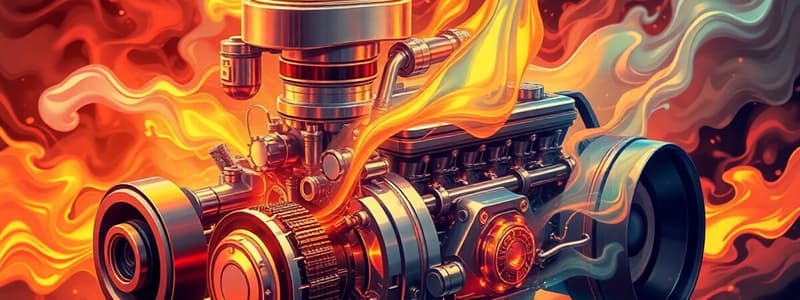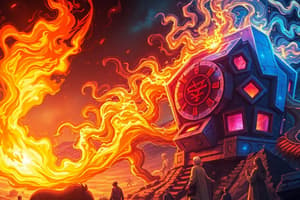Podcast
Questions and Answers
What percentage of the total energy released by combustion is typically used to propel the vehicle?
What percentage of the total energy released by combustion is typically used to propel the vehicle?
- 50%
- 20% (correct)
- 10%
- 80%
Which component is primarily responsible for the combustion process in an internal combustion engine?
Which component is primarily responsible for the combustion process in an internal combustion engine?
- Oxygen
- Hydrocarbons (correct)
- Nitrogen
- Water vapor
As the efficiency of an engine increases, what happens to exhaust emissions from the tailpipe?
As the efficiency of an engine increases, what happens to exhaust emissions from the tailpipe?
- They decrease. (correct)
- They remain unchanged.
- They increase significantly.
- They fluctuate unpredictably.
What has led to the development of advanced closed loop engine control systems in vehicles?
What has led to the development of advanced closed loop engine control systems in vehicles?
What is the primary chemical reaction that occurs during the combustion process in an engine?
What is the primary chemical reaction that occurs during the combustion process in an engine?
Which gases primarily compose air entering an internal combustion engine?
Which gases primarily compose air entering an internal combustion engine?
What is a consequence of failing emission control systems in internal combustion engines?
What is a consequence of failing emission control systems in internal combustion engines?
What type of chemical compounds are hydrocarbons considered to be?
What type of chemical compounds are hydrocarbons considered to be?
What is the ideal air/fuel ratio referred to as?
What is the ideal air/fuel ratio referred to as?
What is a consequence of operating at air/fuel ratios richer than stoichiometry?
What is a consequence of operating at air/fuel ratios richer than stoichiometry?
What is produced during a perfectly operating engine under ideal combustion conditions?
What is produced during a perfectly operating engine under ideal combustion conditions?
During which stroke does the air and fuel move into the cylinder?
During which stroke does the air and fuel move into the cylinder?
What role does the octane rating of fuel play during the Compression Stroke?
What role does the octane rating of fuel play during the Compression Stroke?
What occurs when the spark plug ignites the air/fuel mixture?
What occurs when the spark plug ignites the air/fuel mixture?
Which chemical compound is NOT produced during combustion in an ideal engine?
Which chemical compound is NOT produced during combustion in an ideal engine?
What happens during the Compression Stroke just before the piston reaches Top Dead Center?
What happens during the Compression Stroke just before the piston reaches Top Dead Center?
At what position of the piston is the maximum pressure ideally created?
At what position of the piston is the maximum pressure ideally created?
What are the main combustion by-products if the mixture and spark timing are precise?
What are the main combustion by-products if the mixture and spark timing are precise?
What initiates the Exhaust Stroke in the engine cycle?
What initiates the Exhaust Stroke in the engine cycle?
What is primarily emitted when combustion does not occur at all?
What is primarily emitted when combustion does not occur at all?
What is a notable cause of excessive hydrocarbon emissions in gasoline engines?
What is a notable cause of excessive hydrocarbon emissions in gasoline engines?
Which of the following is NOT a cause of excessive hydrocarbon emissions?
Which of the following is NOT a cause of excessive hydrocarbon emissions?
What happens during the combustion process when there are carbon deposits in the combustion chamber?
What happens during the combustion process when there are carbon deposits in the combustion chamber?
What condition indicates a misfire in an engine?
What condition indicates a misfire in an engine?
What causes an increase in hydrocarbon emissions during a complete misfire?
What causes an increase in hydrocarbon emissions during a complete misfire?
Which scenario typically results in lower emissions of carbon monoxide (CO)?
Which scenario typically results in lower emissions of carbon monoxide (CO)?
What is the primary cause of carbon monoxide being produced in an engine?
What is the primary cause of carbon monoxide being produced in an engine?
What primarily composes the Oxides of Nitrogen (NOx) produced by an engine?
What primarily composes the Oxides of Nitrogen (NOx) produced by an engine?
What operating condition is likely to produce higher concentrations of carbon monoxide?
What operating condition is likely to produce higher concentrations of carbon monoxide?
How does intake air temperature affect hydrocarbon emissions?
How does intake air temperature affect hydrocarbon emissions?
What is the stoichiometric air/fuel ratio ideal for complete combustion?
What is the stoichiometric air/fuel ratio ideal for complete combustion?
Which of the following could NOT be a cause of excessive carbon monoxide emissions?
Which of the following could NOT be a cause of excessive carbon monoxide emissions?
Flashcards are hidden until you start studying
Study Notes
Introduction to Combustion Chemistry
- The combustion process in gasoline engines releases energy stored in the fuel, with only 20% used for propulsion and 80% lost as heat.
- Modern engines are more efficient than older ones, leading to lower exhaust emissions.
- Despite improvements, emission standards continue to tighten, prompting advanced engine control systems.
Understanding the Combustion Process
- Gasoline is primarily composed of hydrocarbons (HC), which are chemical compounds of hydrogen and carbon atoms.
- Combustion requires a mixture of hydrocarbons and air, which is composed of 21% oxygen, 78% nitrogen, and other inert gases.
- The ideal air/fuel ratio for optimal combustion is 14.7:1 (stoichiometry).
- Richer air/fuel ratios negatively impact fuel economy and emissions.
- Leaner air/fuel ratios negatively impact power, driveability, and emissions.
Ideal Combustion Conditions
- In ideal conditions, hydrocarbons react with oxygen to produce water vapor (H2O) and carbon dioxide (CO2).
- Nitrogen (N2) passes through the engine unaffected by the combustion process.
The Four-Stroke Combustion Cycle
- During the Intake Stroke, air and fuel are drawn into the cylinder, with precise fuel delivery for the ideal air/fuel ratio.
- The Compression Stroke increases pressure and heat, requiring high-octane fuel to prevent premature ignition.
- The Power Stroke begins with spark plug ignition, initiating a flame front that spreads through the air/fuel mixture.
- Combustion produces heat and pressure, with peak pressure occurring around 8-12 degrees past top dead center.
- The Exhaust Stroke expels combustion byproducts (water vapor, carbon dioxide, nitrogen, and pollutants) through the exhaust system.
Harmful Exhaust Emissions
- Incomplete combustion leads to harmful emissions.
- Hydrocarbon (HC) emissions are caused by unburned fuel, often due to misfires or wall quenching.
- Carbon monoxide (CO) emissions occur due to incomplete combustion, resulting from oxygen-starved environments.
- Oxides of Nitrogen (NOx) emissions are formed when high temperatures and pressures cause nitrogen to react with oxygen.
Studying That Suits You
Use AI to generate personalized quizzes and flashcards to suit your learning preferences.




